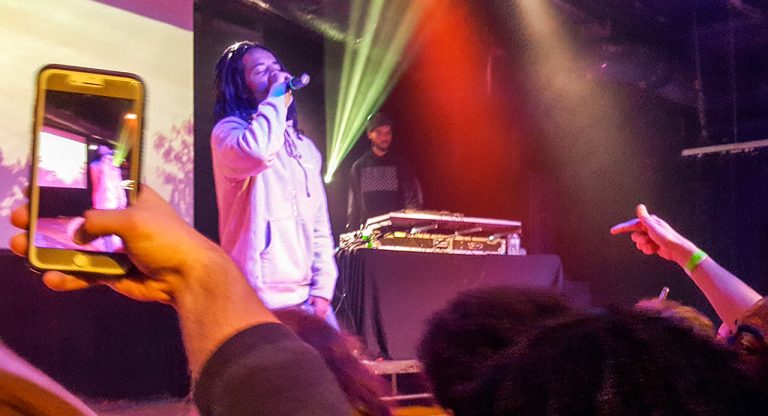By Jack M. Angelo, managing editor
The transition between the oughts and the 2010s brought perhaps the most significant shift in hip-hop’s sound and power structure. Big releases like Man on the Moon Part 2 and My Beautiful Dark Twisted Fantasy helped usher in this new age in the mainstream, but online is where the real change was occurring that would affect hip-hop in the coming decade.
In the late 2000s, a bunch of teens from Southern California got together and created a group they dubbed, “Odd Future Wolf Gang Kill Them All.” This now-defunct group produced artists like Tyler the Creator, Syd (currently of The Internet), Frank Ocean, and of course the group’s most mysterious and elusive member, Earl Sweatshirt.

Earl, born Thebe Kgositsile, began his rap career in the eighth grade and released his first mixtape with Odd Future, Earl, in 2009 when he was only 15 years old. Full of controversial lyrics and immature takes on mature themes, Earl’s age was apparent throughout the short project. However, his signature intricate flow and deep, tired-sounding voice was already a prominent feature in his rapping. Shortly after blowing up along with Odd Future, Thebe was sent to Samoa to a school for troubled boys after reportedly getting into trouble at school.
This period of absence just after his huge splash would become a pattern for Earl. Releasing his comeback project and first official album Doris in 2013, the then 19-year-old solidified his depressive, low-energy intricate rap style. The album clocks in at less than 45 minutes, but remains to this day Earl’s longest project by a significant margin. It would be another couple years of relative silence before Earl Sweatshirt dropped another album with no promotion or lead-up whatsoever (according to Earl, this was a label error), I Don’t Like Shit, I Don’t Go Outside. The album doubled down on the dark, dreary atmosphere Earl had so capably created on his first projects. Now an adult however, the lyrics and delivery had matured to a point of introspection and meaningfulness rarely captured by his contemporaries.
After an even longer break of over 3.5 years, this time without any Samoan explanation, Earl Sweatshirt began dropping some tracks and video snippets, resulting in his November 2018 release unceremoniously titled Some Rap Songs. The brief project once again furthers Earl’s established aesthetic, but this time incorporating a new palette of instrumentalism and lyricism that still reads decidedly Sweatshirt. Thebe is currently on tour supporting the project with his “FIRE IT UP!” tour, which stopped at Baltimore Soundstage on March 28, 2019.

The show began right on time with professional skateboarder and occasional rap artist Na’Kel Smith opening. As soon as Smith took the stage, the crowd began to move violently. The moshing and jumping was immediate and overwhelming. The energy from the young audience was palpable through the whole set, and hardly waned throughout. Nak did not have to do much to move the crowd. The nearly sold out Soundstage came ready. The audience moved so much that is seemed to bother some members less keen on being pushed and squashed in the packed venue.

The next act BbyMutha moved the crowd significantly less, with her songs providing much fewer opportunities for the crowd to jump and mosh. Some persisted, but as the set lingered on, the excitement began to wane. BbyMutha’s somewhat one-note performance began to take its toll, and it was only with significant effort from both BbyMutha and her DJ that some energy was pumped back into the crowd by the end of her set, though it too waned. The few who continued to move violently through BbyMutha’s set started to bother those who were less energetic, furthering the divide between the types of fans at the show.

After another short break, a DJ asked “you guys tired?” after getting little response to a song. The audience responded with a resounding no, to which the DJ brought out two of Earl’s friends who performed a song that riled the crowd up more than even the first opener. Part way through that song, Earl came on the stage. Of course the audience went wild and after the song began, Earl started his set, claiming that he heard the audience may have been tired, and he was not going to allow that.

Earl spent his set interacting and rapping like the veteran that he is. The dark demeanor that comes across in his lyrics and production is traded for a smile and a clear, genuine love for the craft that comes across beautifully during his performance. Running through his just shy of a decade’s worth of material, much of those in attendance knew every word.

The crowd’s response to Earl was positive, loud and boisterous, but those who came just to listen to Earl now had a problem. Anyone even remotely near the stage was being tossed around, with the entirety of the crowd moving from one side of the venue to the other, seemingly unmotivated. The movement did not coincide with the music rhythmically, nor did it seem to fit with what was being played thematically. Halfway through the set, an enormous open pit formed, more akin to a heavy metal show than the low-key sounds of Earl Sweatshirt.

The audience that came to rage were certainly pleased with the evening. Those who came to watch Earl Sweatshirt perform may have had a difficult time doing so. Getting anywhere close to the performance area meant risking life and limb, not to mention the difficulty of getting close in the first place. Earl Sweatshirt is an incredible rapper and experienced performer, in spite of his years of absence from the scene. The age of the crowd seems surprising. Any teen now would have been in elementary school during Earl’s debut. However, Thebe must still be reaching young audiences with his new music. What’s to be seen is if the old audience can handle it.

